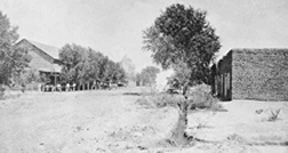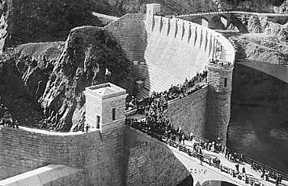History of Central Phoenix

Photo via phoenix.gov
The history of Central Phoenix is long and rich, dating back to 700 A.D. Before this beautiful town was known as Phoenix, its roots started with the natives who occupied the Pueblo Grande ruins between 700 A.D. and 1400 A.D. These ancestors were crafty and intelligent and they built an irrigation system consisting of nearly 135 miles of canals, which made the land fertile and able to produce vegetation. The demise of this early civilization is a mystery, but it is believed that they were destroyed by a continued drought.
Phoenix: The Beginning
Phoenix’s modern history began in the late 19th Century with a man named Jack Swilling of Wickenburg. He was trekking through the mountains one day and he took a moment to rest his horse, when he looked down he saw the Salt River Valley and saw the potential for a new city – all it needed was water. He organized the Swilling Irrigation Canal Company and moved into the valley. By March of 1868 water that was diverted from the Salt River into the valley flowed freely and some of the new residents were able to grow crops. The small colony originally named the area Swilling’s Mill. It was changed to Helling Mill, then Mill City and years later it became known as East Phoenix. A man named Darrell Duppa suggested the name of Phoenix based on the idea that the town was born out of the ruins of a former civilization. Phoenix was officially recognized on May 4, 1868 when the Yavapai County Board of Supervisors (the county of which Phoenix was a part of at the time) formed an election precinct.
Phoenix: The Town Worth $550
By 1870, pioneers continued to make their way into the new Phoenix area and it was clear that a town site had to be established. In February of 1871 Yavapai County was divided and that is when Maricopa County was established by the Legislature. On April 10, 1874 President Grant officially named the present site as Phoenix thru a patent. The total cost of the town of Phoenix was $550 for 320 acres. By the mid 1870s Phoenix was booming with dance halls, saloons, banks, religious establishments and some schools.
Phoenix: Early 1900s

Photo via phoenix.gov
Phoenix continued to grow as a town and a city incorporating horse drawn cars, railroads, automobiles, electricity, higher education establishments, public libraries and more. By the turn of the century the population reached more than 5,500 residents. In 1902 President Roosevelt signed the National Reclamation Act, which made it possible to build dams on western streams. Phoenix and its residents immediately went into action by organizing the Salt River Valley Water Users Association to make sure the precious water supply was well managed. This association actually still functions today to control the use of water in the Valley. The Theodore Roosevelt Dam was started in 1906 and in 1911 the President himself dedicated the dam, which at the time was the largest dam in the world. In 1912, President William Howard Taft approved Arizona’s statehood.
Phoenix: Growing Into a Modern City
By the 1920s the population in Phoenix reached 29,053. Buildings were popping up left and right, among them Arizona’s first skyscraper, the Heard Building. By 1930, Phoenix doubled in size again reaching a population of 48,118. The city had 120 miles of sidewalks, 161 miles of streets, a police force with 70 men, a well-stocked library and a budget reaching more than $2 million. By the 1940s farming was no longer a way of life for Phoenix residents and when the war hit the city quickly turned into an industrial center. After the war many men stayed and brought their families to Phoenix to start a new life. The city was close to running out of water again as their ancient predecessors had, but fortunately they could fall back on great American technology and Phoenix came to know a greater wealth than it ever had before.
Phoenix: Today
Today the city has more than 1.4 million residents and covers more than 500 square miles. Although Phoenix is well known for its corporate establishments it hasn’t forgotten its history, and friendliness is a trait widely respected and practiced by all residents. The citizens of Phoenix are also involved in their city government and have approved more than $3.5 billion for necessary improvements in urban facilities and services since 1950. Among the funded projects are the development of the Phoenix Sky Harbor International Airport, Phoenix City Hall, the History Museum and Arizona Science Center, opening the Central Library and expanding the Phoenix Art Museum. Phoenix is still growing and developing with more than $1 billion in planned private and public projects in the city. The work accomplished by the city government and citizen volunteers in past and present has earned respect and recognition for Phoenix both nationally and internationally.
Needless to say, when a city is endowed with involved citizens and a cooperative city government it will continue to develop and go above and beyond average standards. Phoenix truly lives up to its name, because it started out as a dry and barren desert and evolved into a beautiful and exciting city with numerous shopping and dining options, higher education establishments, world-class hospitals and unparalleled real estate. For more information about the history of Central Phoenix, Phoenix as it is today and all it has to offer feel free to connect with Roberta Candelaria and her team at Phoenix Urban Spaces.
